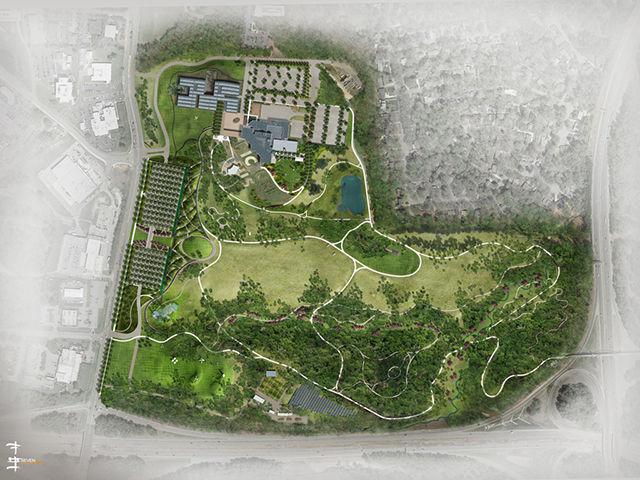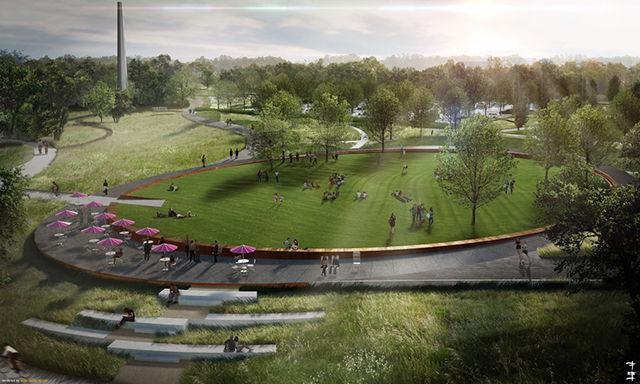The North Carolina Museum of Art is expanding its current 164-acre park with forest restorations, additional trails, outdoor works of art, a new streetscape and more. The expansion replaces a former juvenile prison site and will provide more parking areas and gardens while keeping a sense of improved sustainability in mind. The construction is slated to be finished by the beginning of July 2016.
The museum’s mission is to connect people to art. Dan Gottlieb, the director of planning, design and the museum park for the NCMA, said this museum in particular has a unique asset compared to most being that it has the largest museum art park in the United States.
“In developing an idea of a museum park, it’s thinking about how we bring art to a wider spectrum of our community,” Gottlieb said. “Our land presents an amazing opportunity to use nontraditional methods and means to access a much wider audience.”
The underlying goal of creating the park is to be a beneficial addition to the community as well as to transform the land in a positive way, according to Gottlieb. He said to transform the damaged state prison site into an attractive community place, the team must consider how the expansion can be “a good neighbor and a good citizen” to Raleigh residents.
The expansion of the NCMA’s park could help attract more visitors, including a more diverse group of people, since parks are used more widely and by a larger economic range of people than galleries, according to Gottlieb.
“As far as a very different audience, those that want to recreate, those that want to experience art and nature, it’s gone from zero [people interested] 10 or 12 years ago to more than 150,000 now,” Gottlieb said. “We believe that at the conclusion of this project that we’ll see a very significant bump and more than that, a wide spectrum of the community and people coming from far away who might not go into gallery doors.”
Typically a small percentage of the population uses art museums in a traditional way on a regular basis, according to Gottlieb. Even art museums in populated metropolitan areas experience these low numbers, but the portion of people that use parks and consider them cultural amenities is larger, particularly with younger people.
Design
Unifying both the park and the museum buildings is one of the factors going into the design itself. The park expands this formalized setting into an informal natural setting that interweaves art with nature.
“In terms of design, you can think about it as kind of a gradient, if you will, that’s held together with good design between formal and informal,” Gottlieb said.
The NCMA space has a newer West Building with a more elegant style that presents works of art. Gottlieb oversaw the construction of this particular building and while it is more formal, it has an exterior of 50 percent glass to allow natural light in. The entrances to the outer gardens can be found inside. This unity between formal and informal will be further extended with the park expansion.
“It’s all stitched together with what I hope is an eye to design that has a texture of complexity that is bound together through good circulation and a good kind of experience but changes, if you will, in two directions from formal to informal, traditional to unconventional,” Gottlieb said.
Gottlieb also makes use of memory mapping when designing the park expansion.
Memory mapping is the hierarchy of what lingers in a person’s memory when they think back on an experience, and this hierarchy could be different from what a museum curator thought they were creating, according to Gottlieb.
“When you ask people to draw their experiences or describe it in a different way and kind of put a hierarchy, it sometimes would surprise you,” Gottlieb said. “One thing that is pretty consistent is that experiences with nature frequently are high on the hierarchy of people’s recollection.”
Asking people to draw their hierarchy of experiences, including people from NC State, has been informative for the staff in thinking of what should take priority in terms of the next steps in developing the place, according to Gottlieb.
“The hallmark of a good design for an open space like this is where people can make their own experiences,” Gottlieb said. “It’s more challenging than it sounds to make a space that is kind of experience-neutral but provides a framework for [future experiences].”
Rather than focusing on the technical design details of the paths and park design, more people will think of bringing their families to the park, seeing what exhibition is going on at the time, going to a concert or maybe just relaxing for a day, according to Gottlieb.
Another part of the unifying factor for the park expansion is to bring the museum space up to the street front on Blue Ridge Road, which will create a new campus entrance and improve development in the area. During this, many state properties will be transformed for public-private development, according to Gottlieb.
“We’re sort of the first kid doing this improvement,” Gottlieb said. “Rex Hospital is doing a good job too, but we’re bringing it up to the urban core and hoping that we will — I know that we are — catalyzing good development around us,” Gottlieb said.
Sustainability
Another consideration for this project’s design and future function is the sustainability of the park and the effects on water in the area. Rachel Woods, the exterior curator of horticulture and sustainability, said the extension team has tried to reduce the carbon footprint of the project and reuse some of the materials. One initiative the extension is taking on is water management.
“We tried to reduce the carbon footprint of the project and reuse some of the materials that were already on site,” Woods said.
Two new parking lots will be added during the park expansion, which will increase the amount of surfaces that water cannot pass through. Runoff, or the water that flows over surfaces, then becomes a consideration in the sustainability of the project.
“We’re collecting all the water from those that will go into what we’re calling a water quality band, and then that is sort of a rain garden and then that water then goes a step down to another mechanism called a dissipator where it’s engineered to help the water slowly percolate into the groundwater and reduce the runoff, the surface water that’s running off,” Woods said.
All the steps the water takes down is also cleaning the water, which is important since the museum’s water goes to House Creek and eventually to Jordan Lake, according to Woods. Materials are also being reused from the old prison site, such as the concrete for the dissipater, and about 400 trees will be planted.
“With the planting, we try to use as many native [plants] as possible,” Woods said. “We were able to preserve I think about eight large existing oaks that were on site from the original prison. It was about all together 400 trees that are going in.”
In addition to the actions the extension team is taking to reduce the carbon footprint of the project, Woods said the team is planning long-term goals for the future of the park.
“We’re working on a three-year goal plan right now and also a longer term ‘what direction do we want to take the park in,’ so that’s still kind of in development,” Woods said.
The construction of the park is slated to be finished at the beginning of July, and the official opening will be in November, according to Woods. The existing park will still be fully accessible from the paved greenway path, the parking lot near the East Building and the main parking lot to the right of the museum driveway.
The design of the space overall is geared toward making a memorable experience for the visitors, as well as creating a smaller carbon footprint.
“The idea really is to design a place that welcomes people to create their own experiences and feel really good about it, and that feel like they’re in a place that’s celebrating art and celebrating our natural environment as well,” Gottlieb said.
CONTRIBUTED BY DAN GOTTLIEB
The North Carolina Museum of Art is expanding its current 164-acre park with forest restorations, additional trails, outdoor works of art, a new streetscape and more. The expansion replaces a former juvenile prison site and will provide more parking areas and gardens. The project is planned to complete by the beginning of July 2016.









